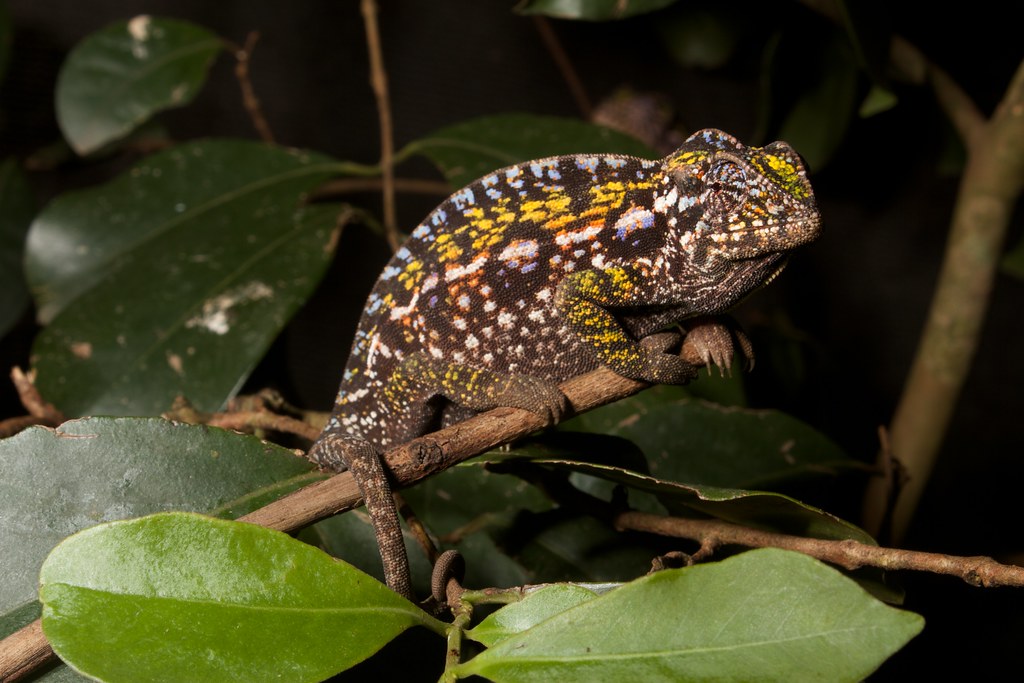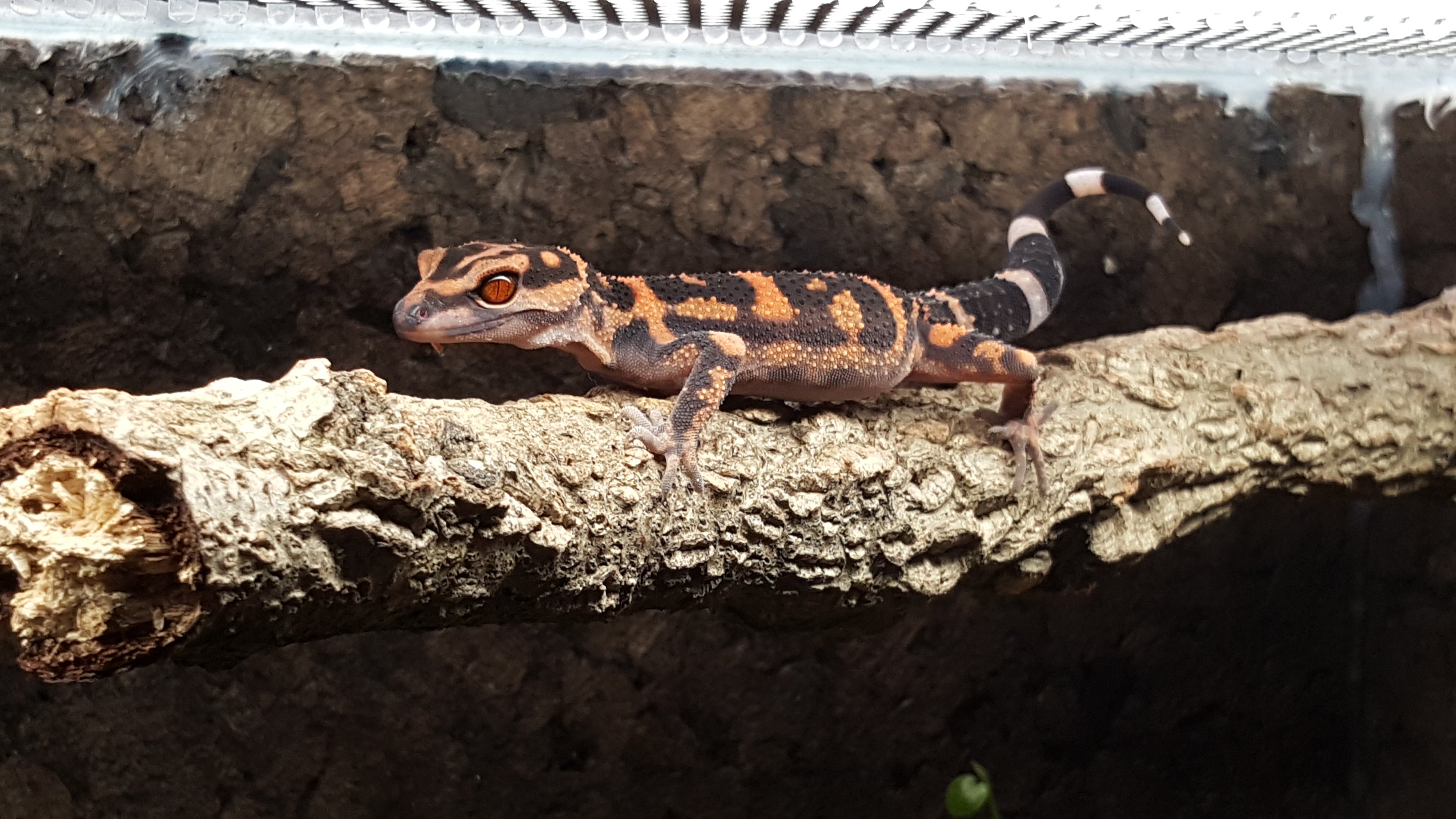Chahoua geckos (Mniarogekko chahoua) are medium-sized, nocturnal, arboreal lizards native to New Caledonia, particularly the islands of Grande Terre and the Isle of Pines. They prefer to hang out in the shaded understory and are not often found in the canopy or higher.
Chahoua geckos’ exact appearance varies with their locale, but generally speaking, they are typically 10-12” long, with a large head, blunted snout, velvety skin, round lidless eyes, vertical pupils, sticky toe pads, and a prehensile tail. Pattern and coloring that mimics moss and/or lichen. This can include a variety of shades of green, brown, red, pink, and white.
Like other New Caledonian geckos, chahoua geckos are fairly easy to care for, and chahoua geckos are recognized as beginner-level reptiles. With good care, they can live 15-20 years.
How much space do chahoua geckos need?
Chahoua geckos may not seem very active compared to some other arboreal lizards, but they are relatively large, and still need an enclosure that is spacious enough to allow them to thermoregulate and exercise other natural behaviors. A single chahoua gecko should be housed in no smaller than an 18” x 18” x 36” terrarium, although larger is always better, and will be happily used!
Cohabitation (keeping multiple chahoua geckos in one enclosure) is not recommended, and may result in fighting if attempted.
Do chahoua geckos need UVB?
They can survive without it, but it’s still recommended. UVB gives them all of the vitamin D that their bodies need, stimulates better appetite and activity, and generally allows them to be healthier than they would be without.
Chahoua geckos do best with low-strength UVB as part of their enclosure. The best UVB bulbs for chahoua geckos housed in an 18” x 18” x 36” terrarium are:
- Zoo Med T8 ReptiSun 5.0, 18”
- Arcadia ShadeDweller Kit, 12”
The UVB bulb should be housed in a reflective fixture and placed close to the heat lamp, about 6” above the basking branch. UVB is blocked by glass and plastic, so you can’t give your gecko UVB by placing its terrarium in front of an open window. Also make sure that the fixture your UVB bulb is in does not have a clear plastic bulb cover.
Chahoua geckos should receive 11 hours of light during winter and 13.5 hours of light during summer. This simulates natural seasonal changes in day length and encourages healthier hormonal rhythms.
What basking temperatures do chahoua geckos need?
Despite popular myth, chahoua geckos do benefit from having a basking area. After all, they’re still ectotherms, which means that they need a temperature gradient in their enclosure to help them regulate their metabolism and stay healthy.
Chahoua geckos should have a low basking temperature between 82-85°F, as measured by a digital probe thermometer with the probe placed on the basking surface. The cool zone in the lower regions of the enclosure should stay between 72-75°F. Heat lamps should be turned off at night. Nighttime temperatures can drop as low as 65°F.
Provide heat for your gecko by imitating the sun with a low-wattage heat lamp placed on one side of the enclosure. Do not use ceramic heat emitters (CHEs), red bulbs, or blue bulbs, as these are not as effective.
What humidity levels do chahoua geckos need?
Chahoua geckos need a high humidity environment with an average humidity of 60-80%, although it can drop as low as 50% and spike as high as 100%. Monitor humidity levels with a digital probe hygrometer with the probe in the middle of the terrarium.
Misting your gecko’s enclosure with a sprayer each evening and again in the morning will help create the right humidity levels. It also provides an important source of drinking water!
What substrate is good for chahoua geckos?
Although chahoua geckos are an arboreal species and don’t spend much time on the ground, placing a layer of substrate on the floor of the enclosure helps maintain humidity. As an added perk, it also tends to make the enclosure more attractive.
Ideally, this substrate should resemble what chahoua geckos naturally live on in the wild — in this case, tropical soil. It should have small particles and hold moisture well. We recommend the following substrates for chahoua geckos:
Layering clean, chemical-free leaf litter on top of the substrate can also help with humidity.
Substrate should be at least 2” deep and completely replaced every 3-4 months. Remove poop and urates daily, along with contaminated substrate.
What décor can you use in a chahoua gecko terrarium?
It’s terribly boring for a gecko to be stuck in an enclosure with nothing in it except substrate and food/water bowls. It doesn’t matter how big the enclosure is if you don’t put things in it for your pet to use and interact with. Chahoua geckos appreciate a fairly densely planted enclosure with either live or artificial plants, which can make their terrarium a great piece of home décor!
At bare minimum, you will need a branch for your gecko to climb on and some live or artificial foliage for it to hide in. However, it’s best to include other items, such as:
What do chahoua geckos eat?
Chahoua geckos are omnivorous, which means that they need to eat a balanced diet of plant and animal matter in order to get the nutrition that their bodies need. In the wild, they primarily eat insects and fruit. In captivity, it’s best to feed them high-quality, specially-formulated crested gecko diet (CGD) supplemented by live insect feeders.
How often chahoua geckos need to eat depends on age:
- Hatchlings and Juveniles (0-12 months) — CGD daily, insects 1-2x/week
- Adults (>12 months) — CGD every 2-3 days, insects 1x/week
Because chahoua geckos are arboreal, CGD should be offered via wall-mounted feeding ledge, not placed on the ground.
Best crested gecko diets: Pangea, Repashy, Leapin’ Leachie, Zoo Med, Lugarti, Black Panther Zoological, Gecko Pro
Feeder insects for chahoua geckos: dubia roaches, discoid roaches, crickets, hornworms, mealworms, darkling beetles
Remember, the key to great nutrition is variety!
Supplements
Although crested gecko diet doubles as a vitamin supplement, you will need calcium powder to dust on feeder insects. We recommend Repashy Supercal NoD.
Water
Although your gecko will get most of its drinking water from daily mistings, it’s a good idea to also provide a wall-mounted water dish. Change the water daily and scrub the bowl with a reptile-safe disinfectant weekly, or whenever it becomes soiled.
Do chahoua geckos like to be handled?
Few reptiles actually “like” to be held, but chahoua geckos generally tolerate handling well. Be gentle, and whenever possible, pick up the gecko from below instead of grabbing it from above — this approach is less scary and stressful for them. They may be a bit jumpy at first, so let them hop from one hand to the other until they have calmed down.
*This care sheet contains only very basic information. Although it’s a good introduction, please do further research with high-quality sources to obtain additional information on caring for this species.
"New Caledonian Mossy PrehensileTailed Geckos (Rhacodactylus chahoua)" by Paul:Ritchie is licensed under CC BY-NC-ND 2.0




Leave a comment
This site is protected by hCaptcha and the hCaptcha Privacy Policy and Terms of Service apply.